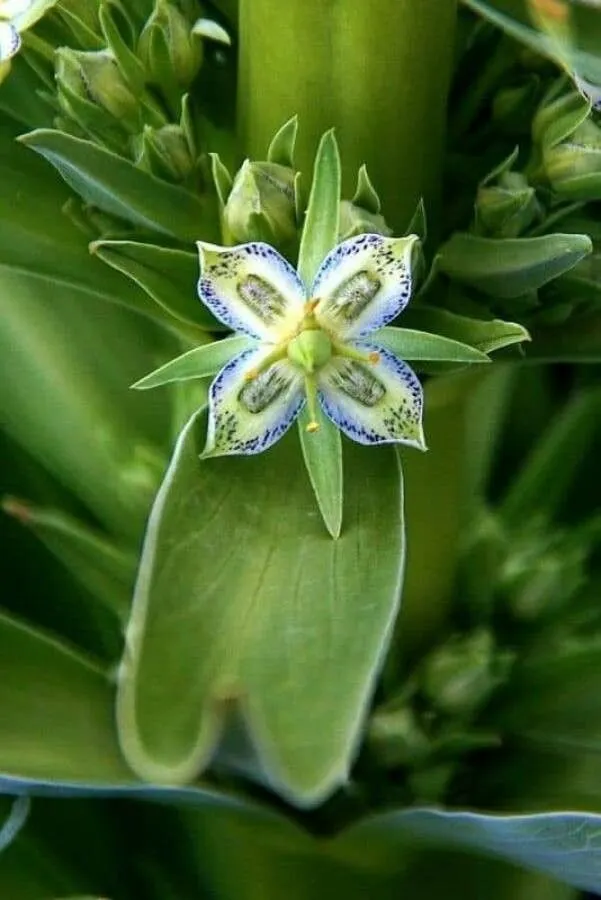
Author: Douglas ex Griseb.
Bibliography: W.J.Hooker, Fl. Bor.-Amer. 2: 66 (1837)
Year: 1837
Status: accepted
Rank: species
Genus: Frasera
Vegetable: False
Observations: W. & C. U.S.A. to N. Mexico
Elkweed, scientifically known as Frasera speciosa, is a striking plant primarily found in the western and central regions of the United States, extending into northern Mexico. This perennial herb belongs to the Gentianaceae family and is notable for its impressive height and vivid floral display, attributes that contribute to its ecological and aesthetic value.
First described by the prominent botanist Douglas and later elaborated upon by Grisebach in W.J. Hooker’s “Flora Boreali-Americana” published in 1837, Elkweed boasts a rich botanical heritage. It thrives in mountainous areas, often gracing subalpine meadows and forest clearings with its presence.
Typically, Elkweed can be identified by its robust stalk, which can grow up to several feet tall, crowned with a dense cluster of star-like, greenish-white flowers. These flowers exhibit distinctive purple speckles, creating a visually appealing pattern that attracts various pollinators, including bees and butterflies. The lance-shaped leaves are arranged in whorls along the stem, giving the plant a symmetrical, architectural appearance.
Beyond its ornamental qualities, Frasera speciosa plays a crucial role in its native ecosystems. It provides habitat and sustenance for wildlife, contributing to the biodiversity and ecological health of its environment. Additionally, the plant has been studied for its potential medicinal properties, a common trait among the Gentianaceae family members, which are renowned for their therapeutic uses.
In summary, Elkweed (Frasera speciosa) stands out not only for its visual beauty but also for its ecological significance and historical relevance in botanical literature. Its presence from the western and central United States to northern Mexico underscores its adaptability and importance within its natural habitat.
En: Elkweed
Nv: Bįįh yiljaaʼí
Taken Aug 1, 1992 by Daniel Barthelemy (cc-by-nc)
Taken Sep 1, 1992 by Daniel Barthelemy (cc-by-nc)
Taken May 1, 2022 by Gilbert Jeanguyot (cc-by-sa)
Taken Jun 28, 2022 by Lawrence Chu (cc-by-sa)
Taken Apr 5, 2022 by Morán Santamaría Patricia (cc-by-sa)
© copyright of the Board of Trustees of the Royal Botanic Gardens, Kew.
Taken Jun 28, 2022 by Lawrence Chu (cc-by-sa)
Taken May 1, 2022 by Gilbert Jeanguyot (cc-by-sa)
Growth habit>: Forb/herb
Family: Myrtaceae Author: (F.Muell.) K.D.Hill & L.A.S.Johnson Bibliography: Telopea 6: 402 (1995) Year: 1995 Status:…
Family: Rubiaceae Author: Pierre ex A.Froehner Bibliography: Notizbl. Bot. Gart. Berlin-Dahlem 1: 237 (1897) Year:…
Family: Sapindaceae Author: Koidz. Bibliography: J. Coll. Sci. Imp. Univ. Tokyo 32(1): 38 (1911) Year:…
Family: Asteraceae Author: A.Gray Bibliography: Pacif. Railr. Rep.: 107 (1857) Year: 1857 Status: accepted Rank:…
Family: Fabaceae Author: Medik. Bibliography: Vorles. Churpfälz. Phys.-Ökon. Ges. 2: 398 (1787) Year: 1787 Status:…
Family: Aspleniaceae Author: (Cav.) Alston Bibliography: Bull. Misc. Inform. Kew 1932: 309 (1932) Year: 1932…